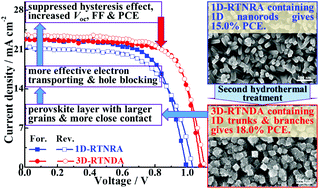Our official English website, www.x-mol.net, welcomes your feedback! (Note: you will need to create a separate account there.)
Improved photovoltaic performance of perovskite solar cells based on three-dimensional rutile TiO2 nanodendrite array film†
Nanoscale ( IF 6.7 ) Pub Date : 2018-10-25 00:00:00 , DOI: 10.1039/c8nr06899b Chi Chen 1, 2, 3, 4 , Shufang Wu 1, 2, 3, 4 , Jinming Wang 1, 2, 3, 4 , Siyao Chen 1, 2, 3, 4 , Tianyou Peng 1, 2, 3, 4 , Renjie Li 1, 2, 3, 4
Nanoscale ( IF 6.7 ) Pub Date : 2018-10-25 00:00:00 , DOI: 10.1039/c8nr06899b Chi Chen 1, 2, 3, 4 , Shufang Wu 1, 2, 3, 4 , Jinming Wang 1, 2, 3, 4 , Siyao Chen 1, 2, 3, 4 , Tianyou Peng 1, 2, 3, 4 , Renjie Li 1, 2, 3, 4
Affiliation

|
In order to explore high performance and stable perovskite solar cells (PSCs), the design and optimization of electron transport layer (ETL) have been paid more and more attention. Vertically oriented, one-dimensional (1D) TiO2 nanostructured array films are considered superior ETLs because of their rapid electron transporting property and open pore architectures. In this study, a three-dimensional (3D) rutile TiO2 nanodendrite array (RTNDA) film containing 1D trunks and branches was fabricated through second hydrothermal treatment of 1D rutile TiO2 nanorod array (RTNRA) film hydrothermally grown on a fluorine tin oxide (FTO) conductive glass. The resulting 3D-RTNDA film not only facilitates close contact with mixed-ion perovskite (Cs0.05(FA0.83MA0.17)0.95Pb(I0.9Br0.1)3) film, but also promotes the formation of a perovskite layer with larger crystal grain sizes. Both can efficiently retard the interface charge recombination, and thus result in a significantly improved power conversion efficiency (PCE) of 18.0%, improved by 20% as compared to that (15.0%) of the device fabricated with the 1D-RTNRA film. Spectroscopic, electrochemical and photoelectrochemical measurements indicate that the improved photovolatic performance can be mainly ascribed to the largely suppressed hysteresis effect, the increased open-circuit voltage and fill factor stemming from the more effective hole blocking and electron transport. The results presented here demonstrate that 3D-RTNDA film with 3D rutile TiO2 hierarchical nanoarchitecture is a promising ETL selection in designing high-performance PSCs.
中文翻译:

基于三维金红石TiO 2纳米枝晶阵列膜的钙钛矿太阳能电池的光伏性能改善†
为了探索高性能和稳定的钙钛矿太阳能电池(PSC),电子传输层(ETL)的设计和优化已受到越来越多的关注。垂直取向的一维(1D)TiO 2纳米结构阵列膜由于其快速的电子传输性能和开孔结构而被认为是优异的ETL。在这项研究中,三维(3D)金红石型二氧化钛2含有1D树干和树枝nanodendrite阵列(RTNDA)膜通过金红石型二氧化钛1D的第二水热处理制造2纳米棒阵列(RTNRA)膜水热生长上的氧化氟锡( FTO)导电玻璃。所得的3D-RTNDA膜不仅有助于与混合离子钙钛矿紧密接触(Cs 0.05(FA 0.83 MA 0.17)0.95 Pb(I 0.9 Br 0.1)3)膜,但也促进了具有较大晶粒尺寸的钙钛矿层的形成。两者都可以有效地延迟界面电荷的复合,从而导致功率转换效率(PCE)显着提高,为18.0%,与用1D-RTNRA膜制造的器件的功率转换效率(15.0%)相比,提高了20%。光谱,电化学和光电化学测量表明,改进的光电子性能主要归因于大大抑制的磁滞效应,由更有效的空穴阻挡和电子传输引起的增加的开路电压和填充因子。此处显示的结果表明,具有3D金红石型TiO 2的3D-RTNDA膜 在设计高性能PSC时,分层纳米体系结构是有希望的ETL选择。
更新日期:2018-10-25
中文翻译:

基于三维金红石TiO 2纳米枝晶阵列膜的钙钛矿太阳能电池的光伏性能改善†
为了探索高性能和稳定的钙钛矿太阳能电池(PSC),电子传输层(ETL)的设计和优化已受到越来越多的关注。垂直取向的一维(1D)TiO 2纳米结构阵列膜由于其快速的电子传输性能和开孔结构而被认为是优异的ETL。在这项研究中,三维(3D)金红石型二氧化钛2含有1D树干和树枝nanodendrite阵列(RTNDA)膜通过金红石型二氧化钛1D的第二水热处理制造2纳米棒阵列(RTNRA)膜水热生长上的氧化氟锡( FTO)导电玻璃。所得的3D-RTNDA膜不仅有助于与混合离子钙钛矿紧密接触(Cs 0.05(FA 0.83 MA 0.17)0.95 Pb(I 0.9 Br 0.1)3)膜,但也促进了具有较大晶粒尺寸的钙钛矿层的形成。两者都可以有效地延迟界面电荷的复合,从而导致功率转换效率(PCE)显着提高,为18.0%,与用1D-RTNRA膜制造的器件的功率转换效率(15.0%)相比,提高了20%。光谱,电化学和光电化学测量表明,改进的光电子性能主要归因于大大抑制的磁滞效应,由更有效的空穴阻挡和电子传输引起的增加的开路电压和填充因子。此处显示的结果表明,具有3D金红石型TiO 2的3D-RTNDA膜 在设计高性能PSC时,分层纳米体系结构是有希望的ETL选择。



























 京公网安备 11010802027423号
京公网安备 11010802027423号